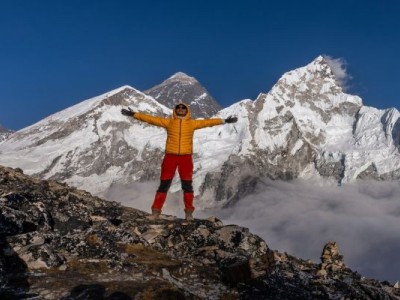Positioned in the heart of the Himalayas, lakes in Nepal are stunning examples of nature's beauty, providing travelers with a unique combination of adventure and serenity. From the pristine waters of Rara Lake to the holy shores of Gosaikunda, these natural spectacles will draw your attention with their visual allure and cultural history. Whether you want enhanced high-altitude trekking experiences in the Annapurna or Everest regions or to experience some tranquil moments next to the calming waters of Phewa Lake in Pokhara, Nepal's varied geography offers more options to explore some of the most beautiful lakes in the world. These lakes are not only enticing destinations for tourists but also dynamic ecosystems and sacred areas for pilgrimage that have shaped Nepalese culture for centuries.
Table of Contents
Top 10 Most Beautiful Lakes in Nepal
Rara Lake – The Queen of Lakes
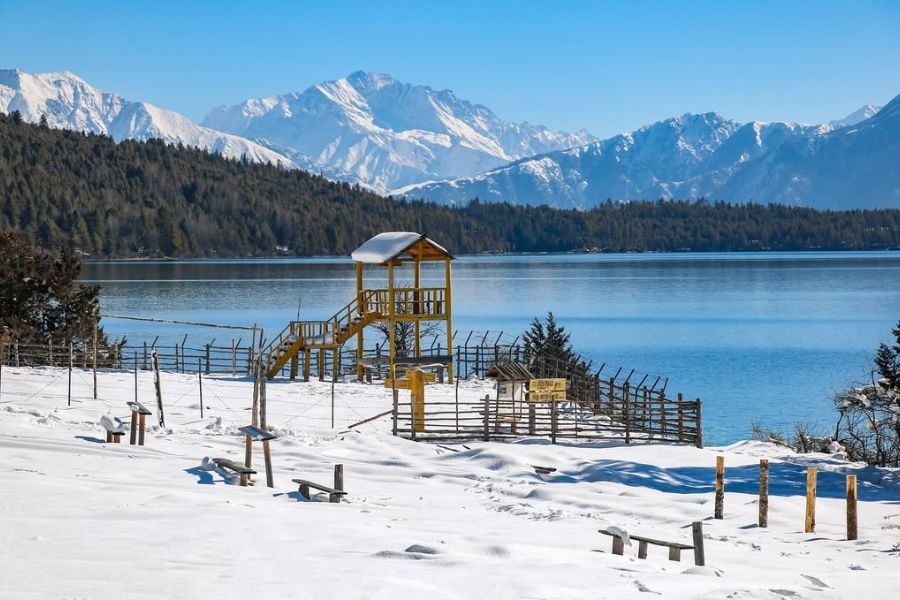
Located in eastern Mugu, in the remote northwest of Nepal, Rara Lake is the largest lake in Nepal, covering roughly 10.8 square kilometers. Rara Lake is located at 2,990 meters above sea level, which puts the lake at a high altitude and surrounds it by snow-capped mountains and thick pine forests, offering spectacular views of one of the country's pristine alpine lakes with deep blue water.
It has crystal-clear water that appears deep blue and reaches depths of 167 meters, offering stunning reflections of the surrounding sizable Himalayan ranges. The seasons change the colors of the lake water from bright blue in the fall to partially frozen white and blue in the winter. The surrounding area is protected by Rara National Park and is home to several endangered species, such as the red panda and musk deer, as well as abundant bird life.
There are two options to reach Rara Lake: a very challenging multi-day trek through remoteness or a series of flights that will lead to Talcha Airport and then a short trek to Rara Lake. The journey itself leads you through some of the spectacular and rugged landscapes of western Nepal, making the adventure worthwhile for those seeking incredible scenery without the crowds of tourists.
Best time to visit: September to November and April to May
Trekking region: Mugu district, Western Nepal
Tilicho Lake – The World's Highest Lake
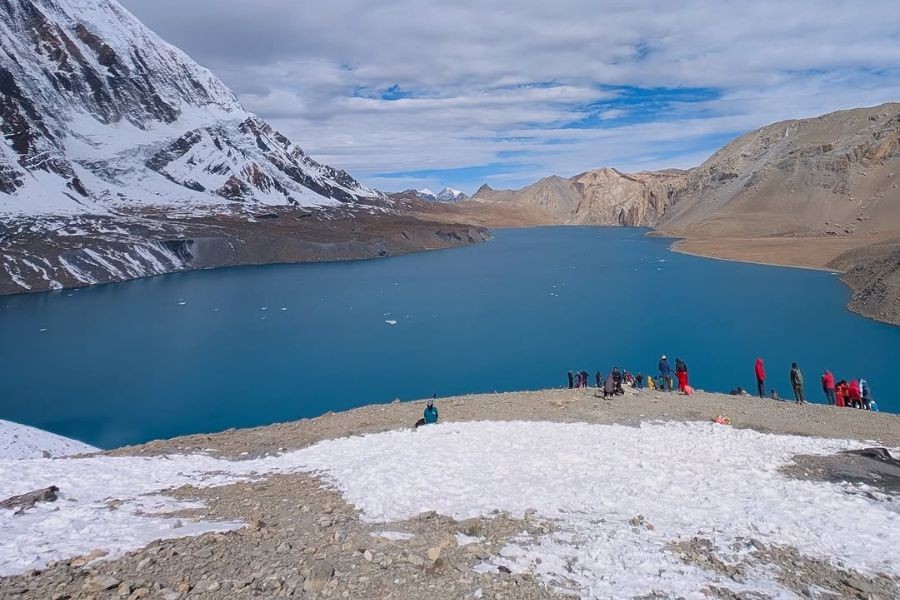
Located at a breathtaking elevation of 4,919 meters in the Annapurna region, Tilicho Lake, Nepal, is recognized as one of the highest lakes in the world. This glacial lake spans an area of 4.8 square kilometers, exhibiting the hardest aspect of natural beauty.
The trek to Tilicho Lake is part of the famous Annapurna Circuit trek; however, it requires trekking off the Annapurna Circuit trail. The trek to the lake requires navigating challenging terrain, including steep gradients, along with a higher risk of altitude sickness. The experience can be incredible! The turquoise lake of Tilicho with the Great Barrier the peaks Tilicho Peak, Nilgiri, etc. in the background is stunning.
The lake partially freezes during the year and only melts slowly in the summer months. It's a remote area with difficult access means few visitors actually trek to the lake for the experience, which retains the wilderness experience.
Best time to visit: May to October (pre-monsoon and post-monsoon)
Trekking region: Annapurna Circuit, Manang district
Shey Phoksundo Lake – The Deep Blue Gem of Dolpo
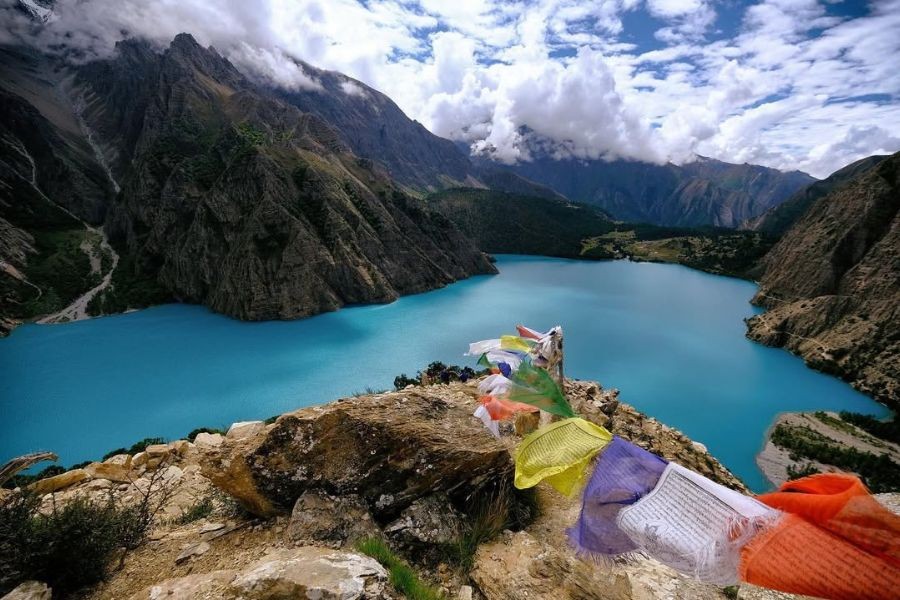
Shey Phoksundo Lake, situated in Nepal's remote Dolpo region, captivates visitors with its incredible turquoise-blue color due to the mineral deposits and depth, at 145 meters. The alpine freshwater lake sits at an elevation of 3,611 meters in Shey Phoksundo National Park and has a surface area of around 4.9 square kilometers. It received international attention when it served as the backdrop for Eric Valli's film “Caravan” and, more recently, literary explorations of the remote Dolpo region. The area combines Tibetan Buddhist culture and the dramatic scenery of the Himalayas with waterfalls, cliffs, and ancient monasteries.
An unusual characteristic of the lake is that it never completely freezes over during harsh winters, owing to its depth. This has manifested in local legends and spirituality. Nearby Ringmo village offers some insight into the lifestyle of members of the Dolpo society, who are adherents of Tibetan Buddhism and maintain traditions they have practiced for centuries.
Best time to visit: May to October
Trekking region: Dolpo region, Upper Dolpo Circuit
Phewa Lake – The Heart of Pokhara

Phewa Lake in Pokhara is at the heart of Nepal's adventure capital, where nature meets tourists' needs. This 5.23-square-kilometer lake is at an elevation of 742 meters and boasts gorgeous reflections of the Annapurna range, including the iconic Fish Tail, otherwise known as Machhapuchhre.
Unlike remote lakes in the high country, Phewa Lake is easy to access and has plenty of activities. Visitors to the lake can enjoy a boat ride across the lake's serene waters, stand-up paddleboard as the sun rises, or relax at one of the many lakeside cafes while enjoying stunning vistas of the mountains. There is also an important cultural component to this natural wonder, the Tal Barahi Temple, located on an island in the center of the lake.
The lakeside area has developed into a tourism mecca, complete with hotels, restaurants, shops, and adventure sports operators all along the waterfront. Paragliders often land near the lake after flying high above Pokhara's valley, making it a main attraction for adventure. Despite the tourist development, Phewa Lake still retains some of its charm, especially in the early morning hours when mist hangs above the lake's water and the mountains peak through the shimmering golden light.
Best time to visit: Year-round, with October to March offering the clearest mountain views
Trekking region: Pokhara valley, gateway to the Annapurna region
Gosaikunda Lake – The Sacred Himalayan Lake

Located at 4,380 meters within Langtang National Park, Gosaikunda Lake is of great religious importance to both Hindus and Buddhists. According to the Hindu story, after drinking poison, Lord Shiva created this alpine body of water by piercing his trident into the mountain to secure water to quench his thirst.
During the Janai Purnima festival in August, the Gosaikunda Lake trek draws thousands of pilgrims, who make the difficult journey to take holy dips in the freezing waters. The lake freezes from December to April, creating a fantastic winter scene.
Often, trekkers begin the Gosaikunda trek from Dhunche or Sundarijal and travel through beautiful rhododendron forests, traditional Tamang villages, and high pastures. The trek passes through several small lakes before reaching Gosaikunda, but many trekkers continue to Lauribinayak Pass (4,610 meters) to see the spectacular Himalayan scenery.
Best time to visit: April to June and September to November (or August for the festival)
Trekking region: Langtang region, Rasuwa district
Ghodaghodi Lake – The Wetland Sanctuary

Situated in the Kailali district of far western Nepal, Ghodaghodi Lake exhibits a distinct ecosystem from the lakes formed from glacial meltwaters at high altitudes. The Ghodaghodi lake system is a wetland complex of lakes and wetlands at an elevation of only 205 meters, which became a Ramsar site (wetland of international importance) in 2003.
The Ghodaghodi lake system consists of over 2,500 hectares of wetlands, which include several interconnected lakes, marshlands, and forested areas. As a biodiversity hot spot, this important wetland area has a range of aquatic plants, many different fish species, numerous waterbirds, and other aquatic wildlife. In the winter season, migratory waterbirds from Siberia and other northern regions also call this wetland home, making it a birdwatching paradise.
The area has cultural significance to the local communities, including several temples along the shore. Thus, Ghodaghodi Lake has natural beauty, ecological significance, and cultural heritage, making it an essential conservation area. Furthermore, unlike the challenging high-altitude trails for mountain lakes, Ghodaghodi Lake is easy to access and is suitable for everyone.
Best time to visit: November to March for birdwatching
Region: Kailali district, Far Western Nepal
Tsho Rolpa Lake – Hidden High-Altitude Treasure
At an altitude of 4,580 meters and in the Rolwaling valley of Dolakha district, Tsho Rolpa Lake is one of the largest glacial lakes in Nepal. It covers a surface area of about 1.65 square kilometers. This stunning lake is formed behind a natural moraine dam and is continuously increasing in size due to glacial melt, which makes it both beautiful and of scientific value.
The trek to Tsho Rolpa provides the challenge of a trek combined with cultural aspects. The trail will take you through Sherpa villages, terraced fields, and different forest zones, prior to entering the high alpine area. The lake itself is spectacular because of the turquoise color of the water and great glacial features and peaks, including Gaurishankar (7134m).
Due to concerns about glacial lake outburst floods (GLOFs), the lake has been monitored by scientists. Researchers have taken measures to lower the water level of the lake and reduce risks to communities below the lake, making it a significant area to study the effects of climate change in the Himalayas.
Best time to visit: May to October
Trekking region: Rolwaling valley, Dolakha district
Bishazari Lake – The Thousand Lakes

Bishazari Lake, often recognized as a neighbor of Begnas Lake, is a group of many smaller ponds and wetlands in the Chitwan area. The name "Bishazari" literally means "twenty thousand" in Nepali, though it really means an abundance of smaller water bodies rather than that exact number.
Bishazari Lake is located in the buffer zone of Chitwan National Park, and the area is an important ecosystem for wildlife habitat. The wetlands area is home to numerous bird species, including some endangered species, thus making it a popular destination for bird watchers and nature photographers. Additionally, wetlands are an important breeding ground for fish and amphibians.
The area around the lake provides tranquil walking trails through the forests and wetlands, thus allowing visitors to become immersed in the natural beauty of the Terai, without all the human traffic at other major tourist sites. Members of local communities are creating eco-tourism opportunities for income while simultaneously trying to conserve the fragile ecosystem.
Best time to visit: October to March
Region: Chitwan district, Central Nepal
Gokyo Lakes – The Sacred Lakes of Sagarmatha
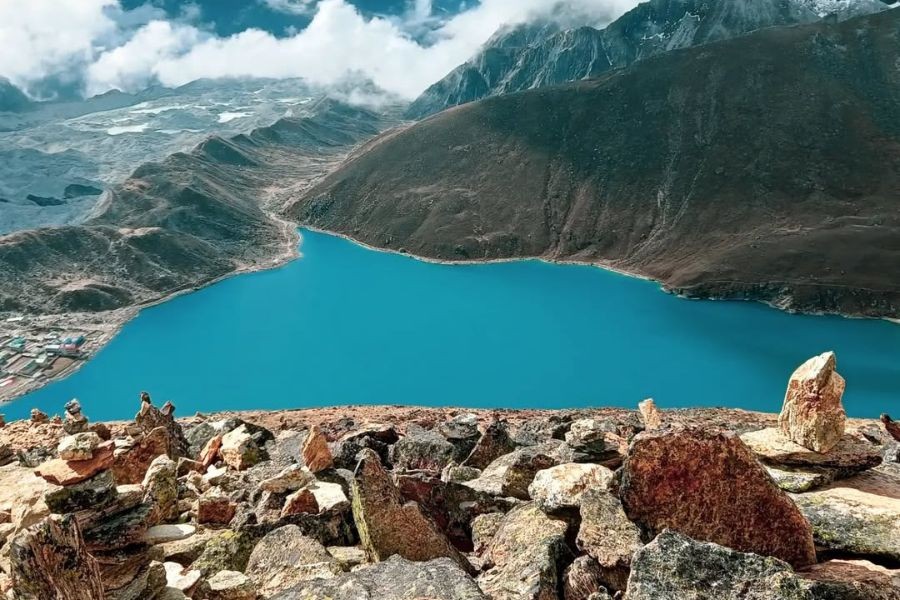
The Gokyo Lakes are a series of six principal glacial lakes in the Everest region, which are located between 4,700 and 5,000 meters above sea level. These beautiful turquoise lakes are located within Sagarmatha National Park and are revered by local Sherpas, and are often used by trekkers in the Everest region as an alternative route.
Gokyo Ri (5,357m), a peak above the lakes, is considered to be one of the most incredible vistas in the Himalayas, as it overlooks four of the tallest mountains in the world: Mount Everest, Lhotse, Makalu, and Cho Oyu. The main lake, Thonak Tsho, is the largest and most well-visited lake and is surrounded by prayer flags and rock monuments.
The Gokyo Lakes trek takes approximately 12-14 days in total, and can be done in conjunction with the classic trip to Everest Base Camp via Cho La Pass. The route provides opportunities to experience Sherpa culture in villages, has spectacular mountain views, and exposure to a unique high-altitude lake ecosystem. Every August, Hindu pilgrims come to these lakes to perform rituals during the Janai Purnima festival.
Best time to visit: March to May, and September to November.
Trekking region: Khumbu, Solukhumbu district (Everest region)
Birendra Lake – The Alpine Serenity
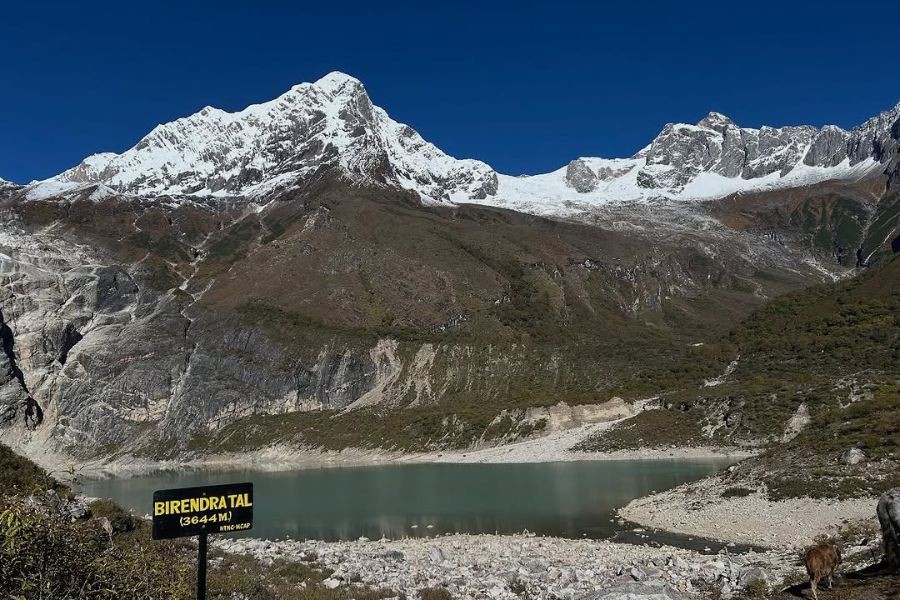
Birendra Lake, located at roughly 3,450 meters in the Manaslu Conservation Area, provides trekkers with a tranquil alpine experience away from the busier trails. This glacial lake is part of the Manaslu Circuit trek, one of Nepal's most stunning trekking adventures that circumnavigates the world's eighth-highest mountain.
The lake features the distinctly turquoise tone that characterizes all glacial-fed bodies of water, highlighted by meadows of wildflowers during spring and summer. The site is excellent for camping, and many trekkers will spend additional time here to acclimatize to the elevation and enjoy the silence of the surroundings.
The area surrounding Birendra Lake clearly delineates the transition from lush forests that characterize lower elevations to the extensive high alpine terrain. Wildlife, including Himalayan tahr and several species of birds, often inhabit the surrounding areas. The lake stands as a testament to the beauty that nature can form even in the most remote and difficult environments.
Best time to visit: September to November and March to May
Trekking region: Manaslu Circuit, Gorkha district
Religious and Cultural Significance of Lakes in Nepal
In Nepal, sacred lakes go beyond their natural aesthetics to become spiritual landmarks interwoven in the culture of religion of the nation. For centuries, these bodies of water have been visited as a site of pilgrimage, meditation, and in religious rites for Hindus and Buddhists alike.
Hindus, for example, consider some lakes to be manifestations of God's presence. With its association with Lord Shiva, Gosaikunda Lake is an important location for pilgrimage, specifically in Janai Purnima, when thousands of worshipers make the trek to the edge despite taxing travel. As told in myth, to dip yourself into the lake cleanses every sin, and blessings will be granted.
Buddhists generally regard high-altitude lakes in the high Himalayas to be sacred. In particular, the Gokyo Lakes, also referred to as the holy lakes in the Everest region, are important religious sites because the Sherpas conduct religious ceremonies and place prayer flags around the lakes. This reflects their religious belief in the power of natural processes to be spiritually powerful.
Lakes frequently serve as the focal point of local festivals and rituals. In various communities, celebrations take place to recognize the water spirit; to honor sacred water deities; and to seek blessings for agricultural production while maintaining a balanced relationship with nature. These traditions encourage a conservation ethic, as residents feel both a spiritual obligation and a practical necessity to protect these lakes.
The cultural significance is echoed in local folklore, including innumerable stories that describe how the lake came to be, involving gods, demons, or mythical happenings that are commemorated in tales engaging the community. These stories connect generations of people and create continuities in the cultural heritage and respect for the natural wonders of our ecosystems.
Make an inquire to travel these magnificent destination in Nepal with Himalayan Ecological Trekking!
Inquire Now: [email protected]
Expert Consultation: WhatsApp: +977 9851006023 (Bikesh)
.jpg)


